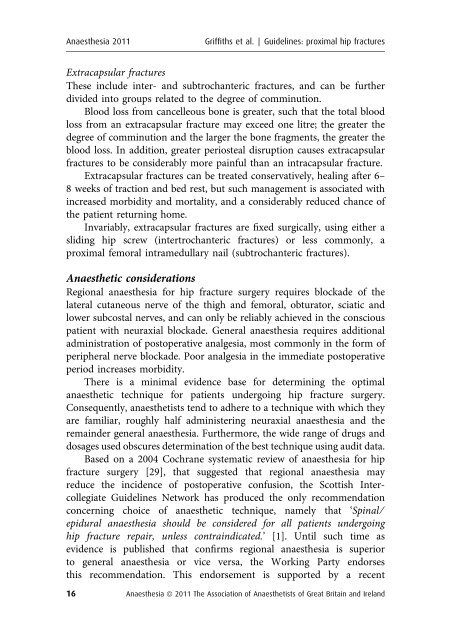Management of Proximal Femoral Fractures 2011 - aagbi
Management of Proximal Femoral Fractures 2011 - aagbi
Management of Proximal Femoral Fractures 2011 - aagbi
You also want an ePaper? Increase the reach of your titles
YUMPU automatically turns print PDFs into web optimized ePapers that Google loves.
Anaesthesia <strong>2011</strong>Griffiths et al. | Guidelines: proximal hip fracturesExtracapsular fracturesThese include inter- and subtrochanteric fractures, and can be furtherdivided into groups related to the degree <strong>of</strong> comminution.Blood loss from cancelleous bone is greater, such that the total bloodloss from an extracapsular fracture may exceed one litre; the greater thedegree <strong>of</strong> comminution and the larger the bone fragments, the greater theblood loss. In addition, greater periosteal disruption causes extracapsularfractures to be considerably more painful than an intracapsular fracture.Extracapsular fractures can be treated conservatively, healing after 6–8 weeks <strong>of</strong> traction and bed rest, but such management is associated withincreased morbidity and mortality, and a considerably reduced chance <strong>of</strong>the patient returning home.Invariably, extracapsular fractures are fixed surgically, using either asliding hip screw (intertrochanteric fractures) or less commonly, aproximal femoral intramedullary nail (subtrochanteric fractures).Anaesthetic considerationsRegional anaesthesia for hip fracture surgery requires blockade <strong>of</strong> thelateral cutaneous nerve <strong>of</strong> the thigh and femoral, obturator, sciatic andlower subcostal nerves, and can only be reliably achieved in the consciouspatient with neuraxial blockade. General anaesthesia requires additionaladministration <strong>of</strong> postoperative analgesia, most commonly in the form <strong>of</strong>peripheral nerve blockade. Poor analgesia in the immediate postoperativeperiod increases morbidity.There is a minimal evidence base for determining the optimalanaesthetic technique for patients undergoing hip fracture surgery.Consequently, anaesthetists tend to adhere to a technique with which theyare familiar, roughly half administering neuraxial anaesthesia and theremainder general anaesthesia. Furthermore, the wide range <strong>of</strong> drugs anddosages used obscures determination <strong>of</strong> the best technique using audit data.Based on a 2004 Cochrane systematic review <strong>of</strong> anaesthesia for hipfracture surgery [29], that suggested that regional anaesthesia mayreduce the incidence <strong>of</strong> postoperative confusion, the Scottish IntercollegiateGuidelines Network has produced the only recommendationconcerning choice <strong>of</strong> anaesthetic technique, namely that ‘Spinal ⁄epidural anaesthesia should be considered for all patients undergoinghip fracture repair, unless contraindicated.’ [1]. Until such time asevidence is published that confirms regional anaesthesia is superiorto general anaesthesia or vice versa, the Working Party endorsesthis recommendation. This endorsement is supported by a recent16 Anaesthesia ª <strong>2011</strong> The Association <strong>of</strong> Anaesthetists <strong>of</strong> Great Britain and Ireland
















